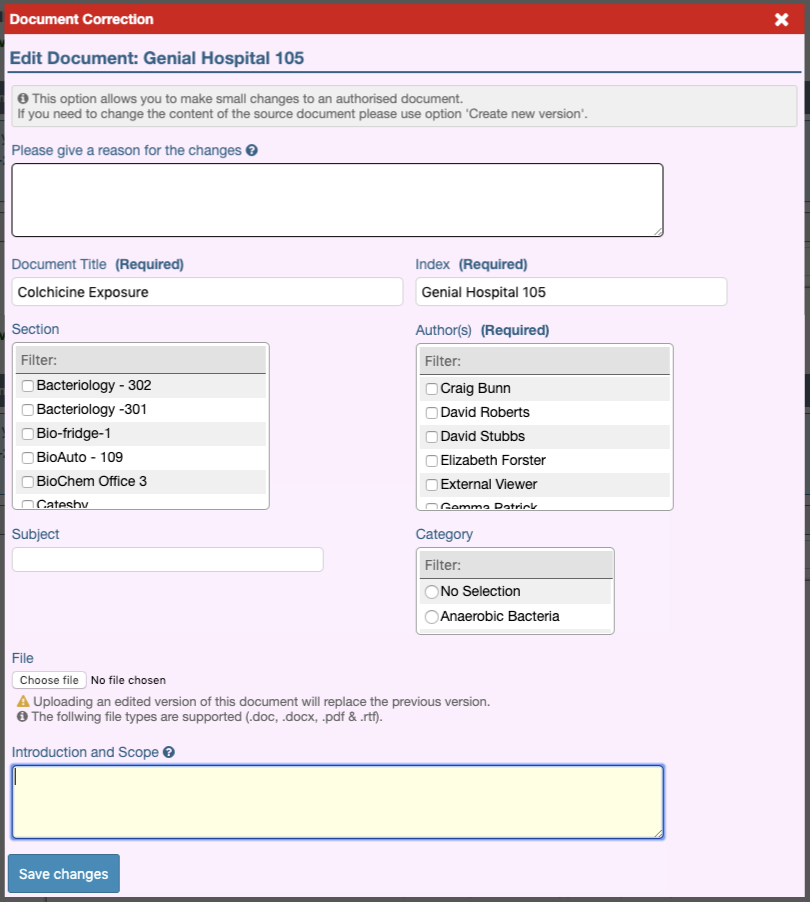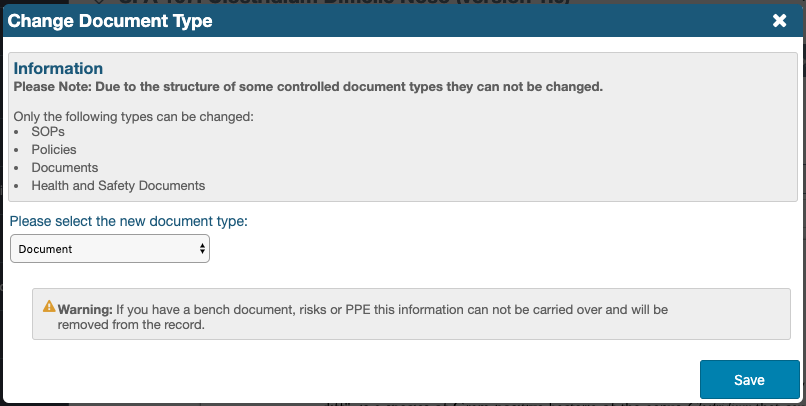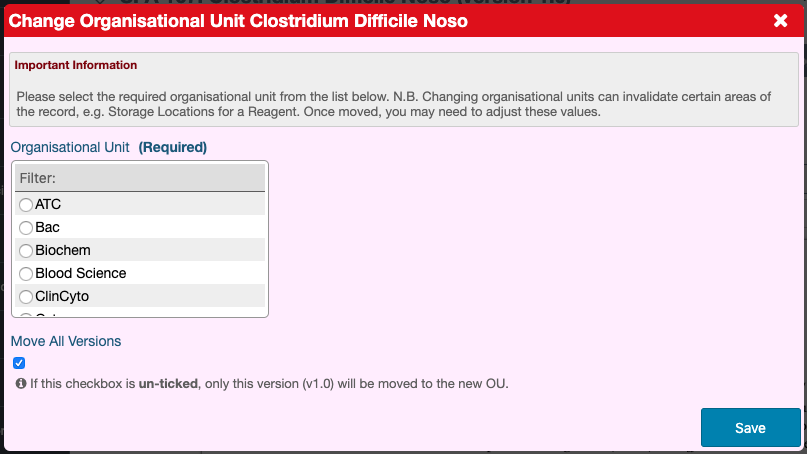- Document Correction of Authorised Controlled Documents
Editing Authorised Controlled documents
Introduction
This article describes the steps required for editing authorised controlled documents within iPassport. Typically, when a controlled document is authorised it is no longer possible to make changes to that document. However, minor errors can occur which don’t merit a whole version change and additional release. As such, it’s possible to make minor changes which don’t justify undergoing another review process by using the feature, Document Correction. Specific preferences and permissions are required to access this procedure so that it’s not used indiscriminately. Since document corrections do not trigger a peer review or authorisation process, this feature should be used with discretion. For example, it’s not recommended to completely replace a document as traceability of changes can be lost.
The Document Correction function allows editing most metadata parameters of controlled documents but there are two parameters that are handled differently - document Type and OU (Organisational Unit). There is a section for this at the bottom of this article (click this link to jump to it: Changing Document Type and OU).
Preferences and Permissions
There is one preference that governs the ability to edit authorised controlled documents and it can be set independently in each OU.
To enable the use of this feature in a selected OU:
- Go to Administration > Settings > Organisational Unit Preferences
- Select the OU to edit from the dropdown menu next to, Organisational Unit:
- Click the row, Document Control to open this section of Preferences
- Tick the checkbox next to, Enable ‘Document Correction’
- Click Save

This setting is not activated in any OU by default; each OU that requires it must have the preference enabled.
In addition, if the preference, “Allow Document Owners to perform any action on their documents, regardless of permissions” is enabled, document owners will be able to perform document corrections, even if they lack the permissions listed below.
There are seven permissions that govern the ability to allow staff members to perform Document Corrections to controlled documents, one for each type of document:
- COSHHs:Allow Document Correction
(This permission allows minor changes only to COSHH records and the same exclusivity applies to all the following) - Documents:Allow Document Correction
- External Documents:Allow Document Correction
- Health And Safeties:Allow Document Correction
- Policies:Allow Document Correction
- SOPs:Allow Document Correction
- Job Descriptions:Allow Document Correction
These permissions are only found in the system role of Administration Editor by default; if they are required in any other role they have to be added. The user must have the permission in the document’s OU for it to be applicable.
Making a Minor Change (Document Correction)
This operation can be done when a document is in ‘authorised’ status (which includes it being ‘under review’) or while ‘pending authorisation’ and provided the OU preference and permissions above are in place. Documents pending authorisation have been included so the authoriser has the choice of making minor corrections at the time of authorising. As well as permitting uploads of edited versions of a document, this feature also allows changing the document Title, Index, Section, Authors, Subject, Category, Introduction and Scope and, if the document hasn’t undergone any changes (i.e., no new authorised versions have been released), the Version Number can be edited too. When a document already has previous versions, the field, Version Number will not be visible.
When editing the title or the index of a document, iPassport still performs its normal validation checks so that details are not duplicated in the OU.
Note that for SOPs, document corrections can be made to the SOP document, the Bench document and the Risks document. It is possible to remove a bench copy from an authorised document without replacing it by using the Document Correction: Bench option.

To make a minor change to a document:
- Open the document to its General tab
- Click the text box next to Actions to the right of the document title
- Select the option, Document Correction from the dropdown menu
- Click Go
- The lightbox that pops up requires a reason to be entered for the log records
- Perform relevant changes and click Save changes

Please note the caption, “This option allows you to make small changes to the authorised document. If you need to change the content of the source document please use option ‘Create new version’ “. Changes to the content of the document will not be formally tracked by this method so it’s not advisable to make significant modifications to the subject matter from a document control point of view.
All changes are recorded within the Log and History tabs of the document in question and can be searched using the filters available.


Changing Document Type and OU
Both the document type and OU can be changed from the Actions dropdown menu, found to the right of every document title when the record is opened. Permissions and restrictions apply - not all changes of type are possible and only OUs that the user can access will be available for selection as a new destination.
Permissions
To change the Document Type, the user must have permissions for both types (source and destination types) so that the option is available. There are 7 related permissions, one for each document type (SOPs:Create SOPs, Policies:Create Policies, etc.) so if for example, a user wants to convert an SOP into a Document, they will need the permissions, SOPs:Create SOPs and Documents:Create Documents in the OU where the document resides. If the user only has the permission for the source type of the document, the Action will be available but there will be no other types to choose from.
To change a document’s Organisational Unit (OU), the same conditions apply - relevant permissions are required in the source and in the destination OUs. These permissions are also classified by type of document (SOPs:Change Organisational Unit, Documents:Change Organisational Unit, etc.) so for example, if a user wants to move a Policy from one OU to another, they require the permission, Policies:Change Organisational Unit in both OUs. If the user only has the permission in the source OU, the Action will be available but no other OUs will be presented as options to move the document.
Owners of documents in OUs where the OU preference, “Allow Document Owners to perform any action on their documents, regardless of permissions” is enabled, will always have the Actions, Change Document Type and Change OU available but they will still require the relevant permission for the destination type or OU.
Site Admins have no restrictions to change controlled document types or OUs.
Changing a Document Type
Some document types carry different information which makes them incompatible with other types. It is sometimes possible to change the type in one direction but not in the other. When Change Document Type is selected, the lightbox that pops-up will list what new types are available for that document. As mentioned above, necessary permissions are required in the first place and then, if it’s possible to convert to a certain type, it will be listed in the corresponding dropdown menu.
To change the document type:
- Open the document under Laboratory Records > Controlled Documents > Search to its General tab
- Click the Actions field and select, Change Document Type from the dropdown menu
- Click Go
- Select the new document type (if available) from the “Please select the new document type” dropdown menu
- Click Save (the “X” on the top right of the lightbox allows cancelling the operation)
In some cases, some information might be lost as there is nowhere to put it. For example, when converting an SOP to a Document, the SOP Bench document, Risks and PPE data will be lost.

Moving a Document to another OU
Provided permissions are in place, it is possible to move only the current version or all versions of a document from one OU to another.
To move a controlled document to another OU:
- Open the document under Laboratory Records > Controlled Documents > Search to its General tab
- Click the Actions field and select, Change OU from the dropdown menu
- Click Go
- Select the new OU (if available) from the “Organisational Unit” search filter (only one OU can be selected)
- Tick the checkbox under Move All Versions if previous versions of the document should be moved with it; untick if only the current version needs to be transferred
- Click Save (the “X” on the top right of the lightbox allows cancelling the operation)
